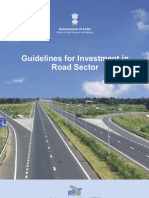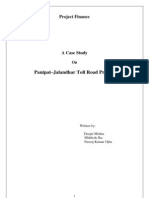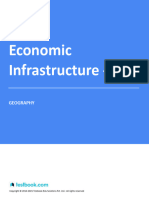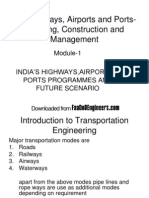C-2
Uploaded by
Nitish KumarC-2
Uploaded by
Nitish Kumar2.
OVERVIEW OF NHAI ORGANIZATION
2.1. OVERVIEW OF NATIONAL HIGHWAYS AUTHORITY OF INDIA
(NHAI)
2.1.1. NHAI Establishment
The National Highways Authority of India was constituted by an act of Parliament, “The National
Highways Authority of India Act, 1988”. It is responsible for the development, maintenance and
management of National Highways entrusted to it and for matters connected or incidental thereto. The
Authority was operationalized in February 1995 with the appointment of full time Chairman and other
Members. Additional information about NHAI activities and other details can be found on www.nhai.org.
The information provided in this report is taken from NHAI website.
2.1.2. NHAI Vision
"To meet the nation’s need for the provision and maintenance of National Highways network to global
standards and to meet user’s expectations in the most time bound and cost-effective manner, within the
strategic policy framework set by the Government of India and thus promote economic wellbeing and
quality of life of the people."
2.1.3. NHAI Mandate
► Primary mandate is time and cost bound implementation of National Highways Development Project
(NHDP) through host of funding options including from external multilateral agencies like World
Bank, Asian Development Bank, JBIC etc. Work mainly comprises of strengthening and four laning of
high-density corridors around 13,146 Kms.
The components are:
o Golden Quadrilateral - 5,846 Kms connecting Delhi-Kolkata-Chennai-Mumbai
o North-South-East-West Corridor-7,300 kms connecting Kashmir to Kanyakumari and Silchar to
Porbandar
► Providing Road connectivity to major Ports.
► Involving the private sector in financing the construction, maintenance and operation of National
Highways and wayside amenities
► Improvement, maintenance and augmentation of the existing National Highways network.
► Implementation of road safety measures and environmental management.
► Introducing Information Technology in Construction, maintenance and all operation of NHAI.
2.1.4. NHAI Organization
A full time Chairman heads NHAI. Member Finance, Member Administration and Member Technical head
their respective departments and report to the Chairman. A detailed organization chart of NHAI is given
in Figure 2-1
2.1.5. National Highway Development Program (NHDP)
The National Highways have a total length of 70,548 km to serve as the arterial network of the country.
The development of National Highways is the responsibility of the Government of India. The Government
of India has launched major initiatives to upgrade and strengthen National Highways through various
phases of National Highways Development Project (NHDP), which are briefly as under:
CANADA | INDIA | ASIA | AFRICA | MIDDLE EAST Page 1
Final Detailed Project Report
Consultancy Services for Preparation of Detailed Project Report for Development of Economic Corridors,
Inter Corridors, Feeder Routes and Coastal Roads to improve efficiency of Freight Movement in India
(Lot1/Madhya Pradesh/Package-1)-Ashram Tiraha to Ratnagiri Tiraha
► NHDP Phase I : NHDP Phase I was approved by Cabinet Committee on Economic Affairs (CCEA) in
December 2000 at an estimated cost of Rs.30,000 crore comprises mostly of GQ (5,846 km) and NS-
EW Corridor (981km), port connectivity (356 km) and others (315 km).
► NHDP Phase II : NHDP Phase II was approved by CCEA in December 2003 at an estimated cost of
Rs.34,339 crores (2002 prices) comprises mostly NS-EW Corridor (6,161 km) and other National
Highways of 486 km length, the total length being 6,647 km. The total length of Phase II is 6,647 km.
► NHDP Phase-III: Government approved on 5.3.2005 up gradation and 4 laning of 4,035 km of National
Highways on BOT basis at an estimated cost of Rs. 22,207 crores (2004 prices). Government approved
in April 2007 up gradation and 4 laning at 8074 km at an estimated cost of Rs. 54,339 crores.
► NHDP Phase-IV: Government approved on 31.10.2013 up gradation and 4 laning of 20,000 km of
National Highways out of which 14,799 km as assigned to NHAI remaining Km with MORT&H.
► NHDP Phase V: CCEA has approved on 5.10.2006 six laning of 6,500 km of existing 4 lane highways
under NHDP Phase V (on DBFO basis). Six laning of 6,500 km includes 5,700 km of GQ and other
stretches.
► NHDP Phase VI: CCEA has approved on November 2006 for 1000 km of expressways at an estimated
cost of Rs. 16680 crores.
► NHDP Phase VII: CCEA has approved on December 2007 for 700 km of Ring Roads, Bypasses and
flyovers and selected stretches at an estimated cost of Rs. 16680 crores.
National Highway Development Project is envisaged to plan, design and construct a network of world
class highways to support the economic growth of the country. Infrastructure in India has been found to
be a bottleneck/ speed breaker for the trade and business, poverty alleviation and economic growth of
the country. An advantage of providing well developed network of highways is as follows:
► Savings in vehicle operating costs by reduced fuel consumption and maintenance costs
► Travel time saving by faster and comfortable journeys
► Safer travel
► Benefits to trade especially in movement of perishable goods
► Reduce demographic shift to urban areas
► Poverty alleviation and all round development of areas
NHDP’s focus is on developing International standard roads with facilities for uninterrupted flow of traffic
with:
► Enhanced safety features
► Better Riding Surface.
► Better Road Geometry
► Better Traffic Management and Noticeable Signage.
► Divided carriageways and Service roads
► Grade separators
► Over bridges and Underpasses
► Bypasses
► Wayside amenities
CANADA | INDIA | ASIA | AFRICA | MIDDLE EAST Page 2
Final Detailed Project Report
Consultancy Services for Preparation of Detailed Project Report for Development of Economic Corridors,
Inter Corridors, Feeder Routes and Coastal Roads to improve efficiency of Freight Movement in India
(Lot1/Madhya Pradesh/Package-1)-Ashram Tiraha to Ratnagiri Tiraha
Finance Mechanisms: NHAI proposes to finance its projects by a host of financing mechanisms. Some of
them are as follows:
2.2. THE GOVERNMENT OF INDIA- BUDGETARY ALLOCATION
In a historic decision, the Government of India introduced a Cess on both Petrol and Diesel. This amount
at that time (at 1999 prices) came to a total of approximately Rs. 2,000 crores per annum. Further,
Parliament decreed that the fund so collected were to be put aside in a Central Road Fund (CRF) for
exclusive utilization for the development of a modern road network. The developmental work that it
could be tapped to fund, and the agencies to whom it was available were clearly defined as:
► Construction and Maintenance of State Highways by State Governments.
► Development of Rural Roads by State Governments
► Construction of Rail over- bridges by Indian Railways
► Construction and Maintenance of National Highways by NHDP and Ministry of Road Transport &
Highway
Today, The Cess contributes between Rs 5 to 6 Thousands crores per annum towards NHDP.
2.3. LOAN ASSISTANCE FROM INTERNATIONAL FUNDING
AGENCIES
Loan assistance is available from multilateral development agencies like Asian Development Bank and
World Bank or Other overseas lending agencies like Japanese Bank of International Co - Operation.
2.4. MARKET BORROWING
NHAI proposes to tap the market by securities cess receipts
2.5. PRIVATE SECTOR PARTICIPATION
Major policy initiatives have been taken by the Government to attract foreign as well as domestic private
investments. To promote involvement of the private sector in construction and maintenance of National
Highways, Projects are offered on Build Operate and Transfer (BOT) basis to private agencies. After the
concession period, which can range up to 30 years, this road is transferred back to NHAI by the
Concessionaries. NHAI funds are also leveraged by the setting up of Special Purpose Vehicles (SPVs). The
SPVs borrow funds and repay these through toll revenues in the future. Some more models have
emerged for better leveraging of funds available with NHAI such as Annuity, which is a variant of BOT
model
2.6. POLICY INITIATIVES FOR ATTRACTING PRIVATE INVESTMENT
► Government will carry out all preparatory work including land acquisition and utility removal. Right of
way (ROW) to be made available to concessionaires free from all encumbrances.
► NHAI / GOI to provide capital grant up to 40% of project cost to enhance viability on a case to case
basis
► 100% tax exemption for 5 years and 30% relief for next 5 years, which may be availed of in 20 years.
► Concession period allowed up to 30 years
► Arbitration and Conciliation Act 1996 based on UNICITRAL provisions.
CANADA | INDIA | ASIA | AFRICA | MIDDLE EAST Page 3
Final Detailed Project Report
Consultancy Services for Preparation of Detailed Project Report for Development of Economic Corridors,
Inter Corridors, Feeder Routes and Coastal Roads to improve efficiency of Freight Movement in India
(Lot1/Madhya Pradesh/Package-1)-Ashram Tiraha to Ratnagiri Tiraha
► In BOT projects entrepreneur are allowed to collect and retain tolls
► Duty free import of specified modern high capacity equipment for highway construction.
2.6.1. Cost Recovery Mechanism
The Government of India has made some policies for attracting the private investors for constructing the
roads and cost recovery method
Policy Initiatives for Attracting Private Investment
► Government will carry out all preparatory work including land acquisition and utility removal. Right of
way (ROW) to be made available to concessionaires free from all encumbrances.
► NHAI / GOI to provide capital grant up to 40% of project cost to enhance viability on a case to case
basis
► 100% tax exemption for 5 years and 30% relief for next 5 years, which may be availed of in 20 years.
► Concession period allowed up to 30 years and during this period, concessionaire will collect toll.
► Toll rates will be decided based on type of vehicle and loading capacity of vehicle.
► Arbitration and Conciliation Act 1996 based on UNICITRAL provisions.
► In BOT projects entrepreneur are allowed to collect and retain tolls
► Duty free import of specified modern high capacity equipment for highway construction.
Bharatmala Pariyojona is a new umbrella program for the highways sector that focuses on optimizing
efficiency of freight and passenger movement across the country by bridging critical infrastructure gaps
through effective interventions like development of Economic Corridors, Inter Corridors and Feeder
Routes, National Corridor Efficiency Improvement, Border and International connectivity roads, Coastal
and Port connectivity roads and Green-field expressways.
The announcement of the mammoth scheme was done by Shri Nitin Gadkari, in the presence of the
Prime Minister Shri Narendra Modi. The implementation of a pan-nation scheme to improve the road
network was the idea of the PM. All key aspects of the scheme will be managed by the Road Transport
and Highways Ministry of the country
Improvement in efficiency of existing corridors through development of Multimodal Logistics Parks and
elimination of choke point
► Enhance focus on improving connectivity in North East and leveraging synergies with Inland
Waterways
► Emphasis on use of technology & scientific planning for Project Preparation and Asset Monitoring
► Delegation of powers to expedite project delivery - Phase I to complete by 2022
► Improving connectivity in the North East
► Budget Allocation of The Scheme
A total of around 24,800 kms are being considered in Phase I of Bharatmala. In addition, Bharatmala
Pariyojana phase -I also includes 10,000 kms of balance road works under NHDP, taking the total to
34,800 kms at an estimated cost of Rs.5,35,000 crore. Bharatmala Phase I - is to be implemented over a
five years period of i.e. 2017-18 to 2021-22.
Key features of the scheme
CANADA | INDIA | ASIA | AFRICA | MIDDLE EAST Page 4
Final Detailed Project Report
Consultancy Services for Preparation of Detailed Project Report for Development of Economic Corridors,
Inter Corridors, Feeder Routes and Coastal Roads to improve efficiency of Freight Movement in India
(Lot1/Madhya Pradesh/Package-1)-Ashram Tiraha to Ratnagiri Tiraha
Improving the quality of roads - The launch of the scheme has been done for bring a new wave of
development in the nation in the form of well-maintained and developed roads. Under this project, the
construction of roads, in all parts of the nation will be undertaken.
Total road construction - As per the draft of the scheme, government and the ministry will strive to
complete new roads, which will add up to a whopping 34, 800 kms.
Integrated scheme - The Bharatmala is the name that is given to the road development and it will include
many other related schemes as well. With the completion of all the schemes, the overall success of the
scheme will be guaranteed.
Total tenure of the program -The central government has the plans of finishing the scheme within a span
of five years. Thus, all is set for finishing the first phase before the end of 2022.
Segmentation in phases - Due to the sheer magnitude and spread of the scheme, it will be divided into
seven distinct phases. As of now, the first phase in under construction.
Constriction on a daily basis - To finish the first phase in time, the respective department has made
efforts of constructing at least 18 km of path on a daily basis. To beat the clock, continued efforts are
being made to raise it to 30 km/day.
Different categories of road construction - It has been highlighted in the official draft of the scheme that
to provide better connectivity, the construction of various categories of roads will be undertaken.
Multi-source of finding - One source will not be enough for funding a mammoth project. Thus, the
government will have to depend on other sources for generating adequate money to meet the expenses.
Bharatmala Project Category
Economic Corridor - As per the guidelines of the road construction project, the construction of 9000kms
of Economic Corridors will be undertaken by the central government.
Feeder Route or Inter Corridor - The total length of the roads, which fall under the Feeder Route or Inter
Corridor category, is a whopping 6000kms.
National Corridor Efficiency Improvement - 5000kms of roads, constructed under the scheme will fall in
the category of National Corridor for the better connection between roads.
Border Road and International Connectivity - Connecting the cities and remote areas, which are situated
in the border regions, the project has kept provision for constructing 2000kms roads that fall in the
Border Road or International Connectivity category.
Port Connectivity and Coastal Road - To connect the areas that are dotted along the shorelines and
important ports, the central government has ordered the construction of 2000km of roads.
Green Field Expressway - The main stress will be given on the construction and development of Green
Field Expressway for better management of traffic and freight.
Balance NHDP Works - Under the last segment, the project will see a construction and maintenance of
about 10,000kms of new roads.
A map of Indian National Highway Roadway Network, current National Highway Development Projects
and National Highways Development Project Year wise is provided for ready reference in Figure 2-2,
Figure 2-2 and Figure 2-3
CANADA | INDIA | ASIA | AFRICA | MIDDLE EAST Page 5
Final Detailed Project Report
Consultancy Services for Preparation of Detailed Project Report for Development of Economic Corridors,
Inter Corridors, Feeder Routes and Coastal Roads to improve efficiency of Freight Movement in India
(Lot1/Madhya Pradesh/Package-1)-Ashram Tiraha to Ratnagiri Tiraha
Figure 2-1: Organization Chart of NHAI
CANADA | INDIA | ASIA | AFRICA | MIDDLE EAST Page | 6
Final Detailed Project Report
Consultancy Services for Preparation of Detailed Project Report for Development of Economic Corridors,
Inter Corridors, Feeder Routes and Coastal Roads to improve efficiency of Freight Movement in India
(Lot1/Madhya Pradesh/Package-1) -Ashram Tiraha to Ratnagiri Tiraha
Figure 2-2: India National Highway Network Map
CANADA | INDIA | ASIA | AFRICA | MIDDLE EAST Page 7
Final Detailed Project Report
Consultancy Services for Preparation of Detailed Project Report for Development of Economic Corridors,
Inter Corridors, Feeder Routes and Coastal Roads to improve efficiency of Freight Movement in India
(Lot1/Madhya Pradesh/Package-1)-Ashram Tiraha to Ratnagiri Tiraha
Figure 2-3: National Highways Development Project
CANADA | INDIA | ASIA | AFRICA | MIDDLE EAST Page 8
You might also like
- Basics Configuration of PBX - Nortel Meridain 81c100% (4)Basics Configuration of PBX - Nortel Meridain 81c26 pages
- Guidelines For Investment in Road Sector (As On 15 January 2013)No ratings yetGuidelines For Investment in Road Sector (As On 15 January 2013)47 pages
- Chapter - 1: Introduction: Document: 1058/RH/REP/FFR/403 - 1 - R1 1 of 4No ratings yetChapter - 1: Introduction: Document: 1058/RH/REP/FFR/403 - 1 - R1 1 of 44 pages
- Case Study On Panipat-Jalandhar Toll Road Project50% (2)Case Study On Panipat-Jalandhar Toll Road Project26 pages
- Sustainable Transport System - May 2017No ratings yetSustainable Transport System - May 2017142 pages
- The Motor Vehicles (Amendment) Bill, 2019No ratings yetThe Motor Vehicles (Amendment) Bill, 20194 pages
- Average Daily Traffic On NH - 42 (2011)No ratings yetAverage Daily Traffic On NH - 42 (2011)25 pages
- Andhra Pradesh Uttar Pradesh Rajasthan Karnataka Maharashtra Gujarat Orissa West Bengal Tamil Nadu Bihar JharkhandNo ratings yetAndhra Pradesh Uttar Pradesh Rajasthan Karnataka Maharashtra Gujarat Orissa West Bengal Tamil Nadu Bihar Jharkhand6 pages
- Annual Report - 2021 (English) - CompressedNo ratings yetAnnual Report - 2021 (English) - Compressed116 pages
- Impact of Covid 19 On Roads - October 2020 PDFNo ratings yetImpact of Covid 19 On Roads - October 2020 PDF17 pages
- Transportation System in India - Study NotesNo ratings yetTransportation System in India - Study Notes25 pages
- Presention AT Japan Road Congress: 30 October 2013No ratings yetPresention AT Japan Road Congress: 30 October 201324 pages
- Left Turn Prohibited: (Ii) Setu BharatamNo ratings yetLeft Turn Prohibited: (Ii) Setu Bharatam1 page
- Gist of Union Budget 2019-20: Download High Quality Study MaterialNo ratings yetGist of Union Budget 2019-20: Download High Quality Study Material25 pages
- E2-Highways, Airports and Ports - Planning, Construction and ManagementNo ratings yetE2-Highways, Airports and Ports - Planning, Construction and Management41 pages
- A. Report of Committee On Innovative Methods of Financing - Sept 2017. 2No ratings yetA. Report of Committee On Innovative Methods of Financing - Sept 2017. 248 pages
- A. Dept of Economic Affairs, Ministry of Finance, Govt of IndiaNo ratings yetA. Dept of Economic Affairs, Ministry of Finance, Govt of India5 pages
- Apr-Jun 2005 - Special Issue On Roads & BridgesNo ratings yetApr-Jun 2005 - Special Issue On Roads & Bridges60 pages
- Compendium of Best Practices in Road Asset ManagementFrom EverandCompendium of Best Practices in Road Asset ManagementNo ratings yet
- Afghanistan Transport Sector Master Plan Update (2017-2036)From EverandAfghanistan Transport Sector Master Plan Update (2017-2036)No ratings yet
- GMS Transport Sector Strategy 2030: Toward a Seamless, Efficient, Reliable, and Sustainable GMS Transport SystemFrom EverandGMS Transport Sector Strategy 2030: Toward a Seamless, Efficient, Reliable, and Sustainable GMS Transport SystemNo ratings yet
- The Rural Connectivity Investment Program: Connecting People, Transforming Lives—India Gender Equality Results Case StudyFrom EverandThe Rural Connectivity Investment Program: Connecting People, Transforming Lives—India Gender Equality Results Case StudyNo ratings yet
- Unlocking the Potential of Railways: A Railway Strategy for CAREC, 2017-2030From EverandUnlocking the Potential of Railways: A Railway Strategy for CAREC, 2017-2030No ratings yet
- Instant Access to Emotions as Original Existences: A Theory of Emotion, Motivation and the Self 1st ed. Edition Demian Whiting ebook Full ChaptersNo ratings yetInstant Access to Emotions as Original Existences: A Theory of Emotion, Motivation and the Self 1st ed. Edition Demian Whiting ebook Full Chapters41 pages
- 22 - AE - 111 - Module - 3 - Recording - Business - TransactionsNo ratings yet22 - AE - 111 - Module - 3 - Recording - Business - Transactions23 pages
- Data Analysis With Excel Practical FileNo ratings yetData Analysis With Excel Practical File34 pages
- Configure ML-1660 For CUPS - Page 2 - UbuntuNo ratings yetConfigure ML-1660 For CUPS - Page 2 - Ubuntu4 pages
- Knowledge, Attitudes, and Practices (Kap) Surveys During Cholera Vaccination Campaigns: Guidance For Oral Cholera Vaccine Stockpile CampaignsNo ratings yetKnowledge, Attitudes, and Practices (Kap) Surveys During Cholera Vaccination Campaigns: Guidance For Oral Cholera Vaccine Stockpile Campaigns41 pages
- M100 Filters: The Most Efficient Hydraulic Filters That Require No External Power SourceNo ratings yetM100 Filters: The Most Efficient Hydraulic Filters That Require No External Power Source6 pages
- 4G Single Radio Access Network (SRAN) : Course Code: TRC-830No ratings yet4G Single Radio Access Network (SRAN) : Course Code: TRC-8303 pages
- Guidelines For Investment in Road Sector (As On 15 January 2013)Guidelines For Investment in Road Sector (As On 15 January 2013)
- Chapter - 1: Introduction: Document: 1058/RH/REP/FFR/403 - 1 - R1 1 of 4Chapter - 1: Introduction: Document: 1058/RH/REP/FFR/403 - 1 - R1 1 of 4
- Andhra Pradesh Uttar Pradesh Rajasthan Karnataka Maharashtra Gujarat Orissa West Bengal Tamil Nadu Bihar JharkhandAndhra Pradesh Uttar Pradesh Rajasthan Karnataka Maharashtra Gujarat Orissa West Bengal Tamil Nadu Bihar Jharkhand
- Presention AT Japan Road Congress: 30 October 2013Presention AT Japan Road Congress: 30 October 2013
- Gist of Union Budget 2019-20: Download High Quality Study MaterialGist of Union Budget 2019-20: Download High Quality Study Material
- E2-Highways, Airports and Ports - Planning, Construction and ManagementE2-Highways, Airports and Ports - Planning, Construction and Management
- A. Report of Committee On Innovative Methods of Financing - Sept 2017. 2A. Report of Committee On Innovative Methods of Financing - Sept 2017. 2
- A. Dept of Economic Affairs, Ministry of Finance, Govt of IndiaA. Dept of Economic Affairs, Ministry of Finance, Govt of India
- Apr-Jun 2005 - Special Issue On Roads & BridgesApr-Jun 2005 - Special Issue On Roads & Bridges
- BIMSTEC Master Plan for Transport ConnectivityFrom EverandBIMSTEC Master Plan for Transport Connectivity
- Compendium of Best Practices in Road Asset ManagementFrom EverandCompendium of Best Practices in Road Asset Management
- Afghanistan Transport Sector Master Plan Update (2017-2036)From EverandAfghanistan Transport Sector Master Plan Update (2017-2036)
- GMS Transport Sector Strategy 2030: Toward a Seamless, Efficient, Reliable, and Sustainable GMS Transport SystemFrom EverandGMS Transport Sector Strategy 2030: Toward a Seamless, Efficient, Reliable, and Sustainable GMS Transport System
- The Rural Connectivity Investment Program: Connecting People, Transforming Lives—India Gender Equality Results Case StudyFrom EverandThe Rural Connectivity Investment Program: Connecting People, Transforming Lives—India Gender Equality Results Case Study
- Unlocking the Potential of Railways: A Railway Strategy for CAREC, 2017-2030From EverandUnlocking the Potential of Railways: A Railway Strategy for CAREC, 2017-2030
- Instant Access to Emotions as Original Existences: A Theory of Emotion, Motivation and the Self 1st ed. Edition Demian Whiting ebook Full ChaptersInstant Access to Emotions as Original Existences: A Theory of Emotion, Motivation and the Self 1st ed. Edition Demian Whiting ebook Full Chapters
- 22 - AE - 111 - Module - 3 - Recording - Business - Transactions22 - AE - 111 - Module - 3 - Recording - Business - Transactions
- Knowledge, Attitudes, and Practices (Kap) Surveys During Cholera Vaccination Campaigns: Guidance For Oral Cholera Vaccine Stockpile CampaignsKnowledge, Attitudes, and Practices (Kap) Surveys During Cholera Vaccination Campaigns: Guidance For Oral Cholera Vaccine Stockpile Campaigns
- M100 Filters: The Most Efficient Hydraulic Filters That Require No External Power SourceM100 Filters: The Most Efficient Hydraulic Filters That Require No External Power Source
- 4G Single Radio Access Network (SRAN) : Course Code: TRC-8304G Single Radio Access Network (SRAN) : Course Code: TRC-830




























































































